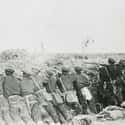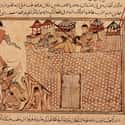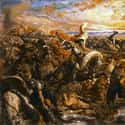-
(#9) Second Battle of the Marne
Although it's popularly viewed as a defensive stalemate, WWI had its share of turning points - like the Second Battle of the Marne, which not only decided the outcome of the war, but also changed the world's political dynamics for the next century.
After the French stopped the German advance on Paris at the First Battle of the Marne in 1914, the Germans employed a mostly defensive strategy on the Western Front while pouring manpower into the East. Three years of bloody stalemates followed, taking millions of lives on both sides.
Then the Bolshevik Revolution toppled the Tsar in 1917, ending Russia's participation in WWI and giving German commander Erich Ludendorff a small window of opportunity. He could now devote all his forces to the Western Front and mount another assault on Paris. But America had recently entered the picture, and newly arriving American troops would neutralize the German advantage. Ludendorff decided on an invasion through the Flanders region to capture the Marne River, which would open a path to the French capital.
On the Allied side, French, British, and Italian troops held the line but were exhausted after years of fighting. The newly arrived American Expeditionary Force bolstered the Allied lines with 250,000 men, but they were inexperienced and in some cases even unequipped. In order to participate, the Americans reluctantly agreed to join the line under French command.
Aware of the impending German attack, the Allies had time to prepare. French commander Philippe Pétain build a series of "decoy" defensive fortifications, trenches that were nearly undefended. Ludendorff began the Second Battle of the Marne by pouncing on the enticing target, only to realize the actual Allied defensive line was miles ahead. The Germans advanced under heavy artillery fire and attacked the Allied lines. But the Allies, including the AEF, held fast and began a counter-offensive. The Germans surrendered a few months later.
The Second Battle of the Marne was the beginning of the end of WWI But it was even more significant because the Americans - untried in European warfare up to that point - proved they could compete against one of the world's strongest military powers. After the battle, the Allies permitted the AEF to operate independently under the leadership of General John Pershing. Second Marne also established a precedent for intervention in overseas conflicts, especially European wars, that has defined American foreign policy ever since.
-
(#1) Battle of Tours
In the Seventh century C.E., the Umayyad dynasty expanded from Syria and established a Muslim caliphate covering most of the Middle East, Turkey, and North Africa. And at the beginning of the eighth century, the Umayyads set their sights on mainland Europe.
An unstable political situation allowed the Umayyads to establish a foothold in Spain. In 710 C.E., Witiza, king of Gothic Spain, died and set off a succession dispute. Rather than support Witiza's heir, Akhila, the Gothic nobles elected Roderick, Duke of Baetica, to be their ruler. Akhila's supporters reached out to the Umayyad ruler for assistance, and the Umayyads helped them defeat Roderick. But they refused to return to Morocco and controlled most of the Iberian peninsula by 712.
As the Umayyads began to venture eastward into modern-day France, this brought them into conflict with the Frankish kingdom, which was ruled by the Merovingian dynasty. In 732 C.E., Abd al-Raḥmān al-Ghafiqi and his Umayyad army sacked Bourdeaux. Shortly after that, the Umayyads met the Frankish army led by its de facto ruler Charles Martel. The clash came to be called the Battle of Tours.
Today, the exact location of the Battle of Tours is unknown, as is what exactly happened. We know that Charles defeated al-Raḥmān, with either a decisive cavalry charge or a heavy infantry attack. In strategic terms, the Frankish victory stopped the Umayyad advance.
To be sure, losing the Battle of Tours wasn't the only reason the Umayyads stopped advancing - there were also internal political divisions that undermined the effort - but it did represent the furthest expansion by a Muslim army into Christian territory. If the Battle of Tours had gone differently, it's possible that Islam would be the dominant religion in at least some of Europe today.
-
(#7) Battle of Yangxia
Most of the battles on this list were decisive because they allowed the winning side to achieve their political goals. The Battle of Yangxia is different. Even though the Qing dynasty technically won the battle, they lost the war in the ensuing negotiations.
In 1911, the ruling Qing dynasty had been in steady decline for centuries, thanks to recurring food shortages and a willingness to allow foreign countries to establish markets within China. So when they decided to nationalize the country's railroads and give control to foreign banks, it sparked the 1911 Revolution, the goal of which was to overthrow Qing rule and establish a Chinese republic. The revolutionaries, led by Sun Yat-sen, were poorly armed and trained compared to the Qing military, but they captured the cities of Hankou and Hanyang. This inspired more to join the effort.
The Qing dynasty and its 6-year-old emperor Puyi were forced to turn to General Yuan Shikai for their rescue. Yuan had formed the powerful Beiyang Army, China's first Western-style armed force, and had become one of the most influential figures in the Chinese government. But Yuan's growing power concerned Qing officials, and following the passing of the dowager Empress Cixi, Yuan was forced into retirement. Now, however, the Beiyang Army was Qings' only hope of suppressing the rebellion. Yuan was put in command of the Qing forces and ordered to retake the cities.
During the ensuing 41-day Battle of Yangxia, Yuan did retake Hankou and Hanyang. But the resistance from the revolutionaries inspired more provinces to declare independence from the Qing dynasty. Realizing the revolution was far from suppressed, and that if he did suppress it his usefulness to the Qing dynasty would end, the ambitious Yuan agreed to a ceasefire and entered negotiations with the revolutionaries.
Rather than assert Qing rule, Yuan instead agreed to allow Sun Yat-sen and the revolutionaries to establish the Republic of China - with Yuan as its president. In exchange, Puyi was forced to formally abdicate the throne. Dynastic rule in China had ended after 2,000 years. But the fragile and unstable Republic of China would itself last for only about three decades before it too fell to the Communist Revolution, with an assist from Japan's ruthless invasion of the 1930s.
-
(#10) Battle of Moscow
Today, the Battle of Stalingrad in 1942-43 is considered the turning point in the Eastern theater of WWII, when Soviet forces finally stopped the German advance and began the long march to Berlin. But if things had gone differently outside Moscow one year earlier, the Battle of Stalingrad likely never would have happened.
Starting with the invasion of Poland in 1939, the German war machine seemed unstoppable, using the Pervitin-fueled blitzkrieg to surprise and confuse Allied commanders and conquer most of mainland Europe. When Hitler launched Operation Barbarossa against the Soviet Union in 1941, at first it seemed like another inevitable German victory.
Beginning in June, the Wehrmacht pushed hundreds of miles into Soviet territory, taking major cities like Minsk and Smolensk and capturing hundreds of thousands of Soviet troops. By September, the Germans had a clear path to Moscow. If they had committed all their forces to attacking the Soviet capital, it's possible they would have irreparably damaged Stalin's government.
Instead, Hitler made the crucial decision to divert some of his forces to attacking other strategically important Soviet cities like Kiev, munitions-producing Stalingrad, and the vast oil fields in the Caucasus region. These delays pushed back the beginning of Operation Typhoon, the code name for the attack on Moscow, to October, the beginning of the inhospitable Russian winter. On October 7, melting snow turned the roads into an impenetrable muddy quagmire, slowing the German advance, which had already been plagued by logistical problems from the beginning of Barbarossa.
The delays gave the Soviets time to fortify Moscow with fresh elite troops from Siberia and the Far East. After the Wehrmacht had come within five miles of the Soviet capital in December, the Soviets eventually pushed them up to 160 miles west. By failing to defeat the Soviets in 1941, the German were eventually forced to fight a war on two fronts, draining their manpower and resources and leading to their downfall. (Of course, the entry of the United States into the conflict in December 1941 didn't help matters.)
-
(#5) Battle of Ain Jalut
The Mongol Empire was one of the greatest military powers the world has ever known. Using his devastating horse archers, Genghis Khan had managed to conquer most of China, Central Asia, and Persia by the time of his passing in 1227. When he passed, it looked like his empire was poised to conquer not just the remaining steppe peoples, but the known world. But 34 years later, an army of enslaved soldiers finally proved the Mongols weren't invincible, and saved their civilization in the process.
In 1251, the new Great Khan, Genghis's son Mongke, ordered his brother Hulagu to finally expand outward from Persia and conquer the remaining Islamic nations in the Middle East and North Africa. Seven years later, Hulagu's forces took Baghdad and executed its caliph, an important symbolic demise that symbolized the end of the caliphate. Hulagu next took the Levant and set his sights on the Egypt, the last major Islamic nation that was controlled by the Mamluks.
A century earlier, the Mamluks had primarily been an elite military force consisting of enslaved soldiers - one that was so respected that some Egyptian parents sold their children into slavery so they could earn the honor of enlisting. They played a major role in helping Saladin repel the Christian Crusades, and over the next century, they eventually became the ruling class in Egypt.
Hulagu sent emissaries to the Mamluk sultan, Quduz, demanding unconditional surrender. But then fate intervened. Hulagu's brother Mongke perished and set off a succession dispute, forcing Hulagu to take the majority of his army to Azerbaijan in case he needed to intervene back home. He left behind a still-formidable force of 20,000 Mongol soldiers.
The Mongols and their new commander, Ked-Buqa, met the Mamluk army at Gaza. During the battle, the Mamluk general Baybars executed a plan that many military commanders have found successful since: using the enemy's favored tactic against them. Baybars ordered a feigned retreat to draw in Ked-Buqa's forces, then fired down on them from three sides until the Mongols were forced to retreat.
Both sides endured heavy losses, but the Mongols fell back to their stronghold in Persia. They would never again seriously threaten the Middle East. As for the Mamluks, Baybars leveraged his success to assassinate Quduz and take power for himself. He established positive diplomatic relationships with many European and Middle Eastern powers and ensured that Mamluk Egypt survived.
-
(#4) Battle of Varna
While the Umayyad dreams of expanding their Islamic caliphate into Europe ceased at the Battle of Tours in 732 A.D., seven centuries later the Ottoman Empire fared much better at Varna. This time, the Ottomans defeated a multi-national crusading force and maintained a foothold in Europe for the next century, all while solidifying their burgeoning empire.
When the Ottomans emerged from Anatolia at the end of the 13th century, the time was right for expansion. The corrupt Byzantine Empire that ruled Constantinople was in rapid decline, struggling to defend its shrinking territory. Meanwhile, for much of the 14th century, Europe would be ravaged a by a Black Plague that devastated the population and disrupted the feudal, land ownership-based economy.
Throughout the 1300s, the Ottomans had taken advantage of Byzantine internal political strife to conquer territory in Eastern Europe, culminating with the Battle of Kosovo in 1389, finalizing their conquest of the Balkans. Though the Central Asian warlord Timur Lenk temporarily threatened Ottoman holdings, by the 1430s the Turks were in the ascendant again.
In 1443, Pope Eugenius IV ordered a crusade against the Ottomans, and after the success of the Long Campaign that year, the Christians signed a peace treaty with Ottoman Sultan Murad II. But many European leaders, like the young Polish-Hungarian King Ladislas III, still hoped to push the Ottomans out of Europe and win glory for themselves. Ladislas was advised by the Papal envoy, Cardinal Cesarini, that since this treaty was signed with an "infidel" Muslim sultan, it was nonbinding.
The next year, the weary Murad II abdicated the throne in favor of his 12-year-old son, Mehmed (later "The Conqueror"). Christian leaders felt that an inexperienced sultan was the perfect opportunity to push the Ottomans out of Europe. Ladislas and his allies agreed that he would lead a multi-national force against the Ottomans, consisting of Hungary, Bohemia, Poland, Lithuania, Croatia, Moldova, Wallachia, Serbia, Bulgarian rebels, and Papal forces. The Crusader army met the Ottomans at Varna, a port on the Black Sea. The force was commanded by Ladislas and the Hungarian warlord John Hunyadi.
Meanwhile, Mehmed brought his father out of retirement to lead the army. The Crusaders had planned to use the Venetian navy to blockade the area and prevent the Ottomans from bringing in reinforcements, but crucially, Mehmed brokered a deal with the Venetians' rivals, the Genoese, to bring in his troops.
The day of the battle, Murad II used a false retreat to entice Ladislas into attacking his position directly. The Crusaders smashed into the Ottoman lines, and at first it seemed like they would break through. But the Ottomans encircled them and their elite Janissaries cut down the knights. Ladislas was beheaded.
The battle had major implications for both sides. Poland had no king for the next three years, and losses were so heavy that it would be several more years before Eastern Europe could mount another attack. As for the Ottoman Empire, defeating their main European rival allowed them to conquer Constantinople and end the Byzantine Empire.
New Random Displays Display All By Ranking
About This Tool
There have been many tragic wars unprecedented in human history, and many important wars have profoundly changed the pattern of the world. When it comes to the turning point of modern society, we have all learned some knowledge about World War II and modern world history in history classes. From the perspective of social development, some countries may have won the battle, but they have not won the war.
On many occasions in history, battles have been decisive for participating countries. The random tool introduced 12 important battles in history that changed the course of our lives today, but few people know these historical events.
Our data comes from Ranker, If you want to participate in the ranking of items displayed on this page, please click here.
















